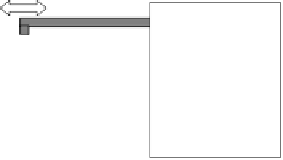Information Technology Reference
In-Depth Information
Disk Platters / Surface
One disk track
Disk Arm
Servo
Figure 3.1
The mechanical structure of a hard disk
can position the disk head to any of the tracks in the disk surface. Note that each disk platter
has its own disk head and all these disk heads are moved in a synchronized manner.
To read data from a sector, the disk controller will first locate the position of the sector in
terms of the track number and platter number. Then it repositions the disk arm to move the
disk head to the destination track and then waits for the sector to rotate underneath the disk
head to begin transferring the data to memory.
To model this data retrieval process we consider two types of processing delay. First, there
are fixed delays that are independent of the amount of data to be retrieved, such as processing
delay at the disk controller, delay in acquiring the data bus for data transfer, and so on. For
simplicity we lump together these fixed delays and represent it by the disk parameter
.
Next we consider the variable delays. First, the time it takes to position the disk head to the
disk track containing the data to retrieve is called seek time, and is represented by the random
variable
t
seek
. Note that seek time depends on two factors - the current location of the disk
head, and the destination track to move to. Second, once the disk head is in the right track, it
will need to wait for the disk sector containing the data to rotate underneath the disk head. This
is known as the rotational latency, and is represented by the random variable
t
latency
. Note that
rotational latency depends on the current sector the disk head happens to be in after seeking,
and the sector containing the data to be retrieved. The rotational latency also depends on the
speed at which the disk platter rotates. For example, if the disk platter is rotating at a speed
of
W
rounds per second, then the latency will range from 0 to
W
−
1
seconds, with an average
and worst-case latency of 0
α
5
W
−
1
and
W
−
1
seconds respectively. This is also why hard disk
manufacturers strive to increase the disk platter rotation speed to improve performance. Finally,
once the disk sector is reached, the actual data transfer will begin. The delay clearly depends
on the rate at which data is transferred - called the disk transfer rate, and the amount of data
to read (assuming it is placed in consecutive disk sectors). In practice, there are additional
complications such as the data to read may span more than one track, or span more than one
disk platter. We will ignore these complications for now and revisit them in Chapter 5.
Therefore, we can model the delay to retrieve a
Q
-byte data block from the disk using the
following equation:
.
=
α
+
β
√
n
Q
R
disk
T
read
(
n
)
+
T
latency
+
(3.1)





























Search WWH ::

Custom Search